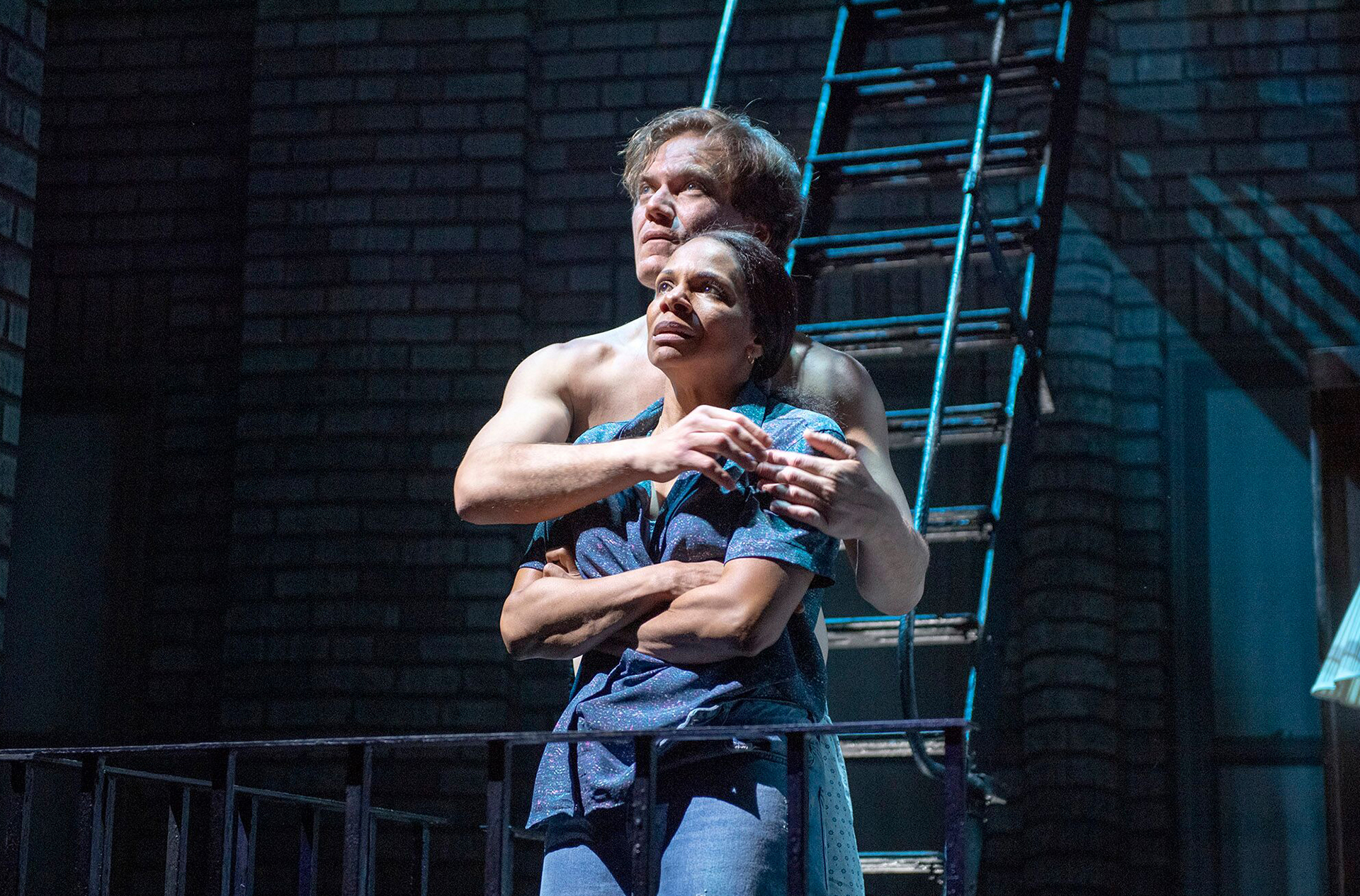Broadway Plays Bring Love & War To Stage

Among the often-repeated clichés that riddle the dialogue between Frankie and Johnny, one that is unspoken registers clearly: Love makes the world go ‘round.
This revival of “Frankie And Johnny In the Clair de Lune,” marking the start of 2019-20 Broadway season, opens on Audra McDonald (Frankie) and Michael Shannon (Johnny) making love. Staged in the dark, and framed as if we’re watching the scene on television, it makes for a highly pleasurable voyeuristic experience. And it is graphic in the most positive sense.
Set (by Riccardo Hernandez) in Frankie’s walkup studio, the back of the apartment blends into the exterior brick wall of the tenement, and the fire escape forms the left side of her apartment. It’s an inside/outside world that puts their most intimate moments out there in the open. No wonder they’re feeling unprotected. They are just two of “9,684,411 New Yorkers” trapped inside themselves, and fearful of intimacy.
As drawn by the playwright Terrence McNally, Frankie and Johnny are two ordinary, working class characters. However, with Audra McDonald and Michael Shannon portraying the couple, we’re granted more than perfect bodies and movie star looks to appreciate, not to mention their outstanding acting.
Among the most beloved of Broadway stars, McDonald betrays her image here, portraying a high school dropout, a beaten and wounded woman. As she forewarns Johnny, “I’m a BLT down sort of person and I think you’re looking for someone a little more pheasant under glass.” She has lots of life to share, but it’s been forged with grit, and shaped by bad breaks. And her romantic past explains why she’s scared of men. She tells Johnny, “This is like ‘Looking for Mr. Goodbar,’” all while he showers her with romantic affection.
Predictably, the action is subtle. But it’s still strategic, a kind of dance, like a Cha-Cha in which he invades, she retreats. He injects humor, she gets angry. He’s gung-ho, she’s wary. He wants to make love, she likes to eat. He’s a cook, she’s a waitress at the same Greek diner where they met.
That McNally’s two-hander, running a full two acts, is so vibrant speaks to the subject; we get to connect with the feelings that love ignites. Also, the characters’ quick and insightful repartee keeps us fully engrossed.
Still, it’s especially exciting to watch these two magnificent actors, who live nakedly on the stage, moment to moment. Together they make a meatball sandwich, listen to beautiful music, watch TV —a joyless event — and discover that they have so much in common. Beyond chemistry, they grow together, creating a form, like a spoon.
Their love, as one may anticipate in a McNally drama, is inspired by the beautiful music they hear. Listening to Bach’s “Goldberg Variations,” and Debussy’s “Clair de Lune” is not a small part of the theatrical experience. Interesting, though, that it’s Debussy. Like McNally’s play, Debussy’s music is known for its improvisational air.
The Plough and The Stars
The Irish Repertory Theatre’s revival of Sean O’Casey’s 1926 play, “The Plough and The Stars,” the conclusion of his Dublin Trilogy, evokes the madness and absurdity of war. As the play opens on a darkly realistic drawing room (Charlie Corcoran), we meet the inhabitants of a Dublin tenement, characters drawn of sharply contrasting nature and sensibility.
Take the way Nora, (Clare O’Malley) fights with Jack (Adam Petherbridge), about attending the Citizen Army meeting. It’s a small version of the war that is beginning, the Easter Rising of 1916, which fueled an ongoing rebellion between Ireland and England.
Director Charlotte Moore mines the colorfulness of O’Casey’s characters, and their behaviors exposing the vulnerability of the urban poor. There’s Nora’s Uncle Peter (Robert Langdon Lloyd), a sentimental and unsympathetic character who glories at posing in his old army uniforms. Later, he squeals at the sight of guns, hides at the thought of endangering his life, and generally acts like a baby in a play where one character dies in childbirth, and another loses her baby in still birth.
There’s the conservative, high-pitched Mrs. Gogan (Una Clancy) whose daughter, Mollser (Meg Hennessy) suffers from consumption. While she struggles to earn every dime, Moser is left alone. James Russell plays The Covey, the socialist, an aloof sort of observer, who spouts theory. Still, under the duress of war, he becomes a practical minded thief.
In the role of Bessie Burgess, the crazy drunk lady, Maryann Plunkett transforms from the coarsest of neighbors to the most giving and charitable character in the play. It’s an extraordinarily vivid and truthful portrayal of a character who discovers in herself a deep sense of charity, even sacrificing her life.
And at the core of it, the two central characters, Jack and Nora, prove sadly that love cannot defeat war. To that end, the Nora we first meet appears clawing, clinging to a middle-class dream of domestic contentment . . . while Jack appears at first so innocently fetching. In these roles, O’Malley and Petherbridge reveal the contrasting and irreconcilable differences at the heart of the play. O’Malley especially brings a lot of sensitivity to Nora’s plight. With the most to gain, their losses are the most maddening.
Fighting the battle of the Irish poor and the dream of independence with his pen, O’Casey demonstrates a surprisingly modern sensibility. As we see it here with actors in period garb, speaking with Irish accents, and with heightened behavior, they look odd. The war they’re so engrossed in is inexplicable. It’s the mirror O’Casey holds up to the senseless nature of war that sings to us here.
And the conflict at the heart of it, the plough that represents the labor of tilling the soil, and the stars that represent the dream. Shall we conclude that “never the twain shall meet”?



